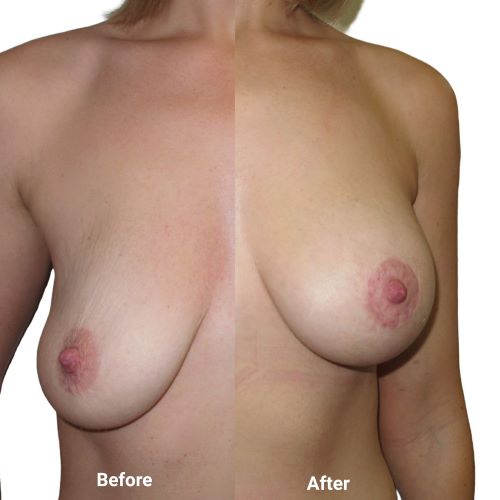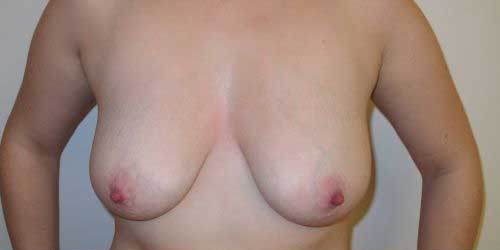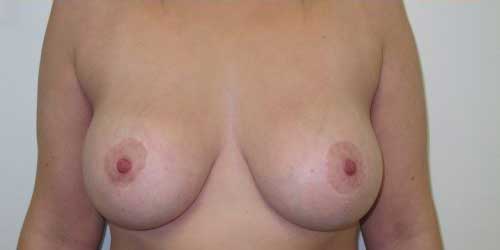
Breast Uplift with Implants
Some situations require combining a breast implant procedure together with a breast uplift. This is primarily for patients who request a cup size increase but have a droopy breast with a low lying nipple. In this situation the nipple will need to be lifted in order for it to be positioned higher and in front of the implant to achieve a satisfactory breast shape. This is a relatively common scenario post pregnancy or post weightloss. However, some individuals may simply have a developmentally droopy breast.
Determining the degree of breast drop which is called ‘ptosis’ is critical to adequate planning of the procedure. Measurements are taken to determine the distance from the base of the neck to the nipple and also a determination of whether the nipple sits above or below the crease under the breast. If the nipple sits below the inframammary crease a mastopexy ( uplift) will be needed at the same time as the breast implant procedure.
The combination surgery is quite complex with many factors to consider. The main issue is that large implants cannot be used together with an uplift . Depending on the chest dimensions usually a one to one and a half cup size increase is generally safe. If larger implants are required, it is best to stage the surgery by performing the uplift first then inserting implants 6 months later.
You can read more about combination breast implant and uplift surgery below.
Am I suitable for breast implant and uplift surgery ?
This surgery is suitable for those individuals wanting an increase in breast size and in whom the breast has dropped with a low lying nipple.
This may occur in the following situations:
- Post pregnancy
- Post weightloss
- Genetically droopy breasts
- Previous breast implants with a breast drop
The Consultation for breast uplift and implant surgery
At the consultation Mr Chana will discuss carefully your desired expectation and examine you to take measurements of your breasts including the position of the nipples. This process is important to decide whether you need an uplift together with breast implant surgery.
It is important to discuss the size of breast implants and a sizing process will take place. You will have a chance to try on breast implant sizers in a sports bra. It is useful to bring a tight fitting T shirt and perhaps other clothing so that you can visualize the potential size of your breasts with and without various clothing.
A full discussion will take place about various implant options and the type of uplift procedure needed.
The breast uplift and implant surgery
The surgery requires a General Anaesthetic and is usually an overnight stay. During the surgery breast implants are inserted and the breast is lifted using one of several techniques.
If a small degree of nipple lift is required it may be possible to confine the uplift scar to just around the areola. This is called a circumareolar lift. In addition the usual scar under the breast for insertion of the breast implants will still be needed.
In many cases a greater degree of nipple lift is needed in which case a vertical scar combined with scar around the areola is required. This is a vertical scar mastopexy or the ‘lollipop’ scar technique.
With greater degrees of lift a full mastopexy is needed with an ‘anchor’ shaped scar which means that along with the lollipop scar an additional horizontal scar is needed in the crease under the breast. The majority of patients will fall into this category.
If drains are used these are removed the next day before you go home after the surgery
The recovery after breast uplift and implant surgery
After the surgery it is important to rest and sleep upright for a few days. The surgery is not too painful and any discomfort is easily controlled with painkillers which are prescribed for you. It is important not to take your own painkillers and especially avoid anti-inflammatory medication such as aspirin or neurofen since this increases the risks of bruising and swelling.
Bruising and swelling tends to subside over the first two weeks. Appointments to remove sutures and to check the wounds are made in the first 2 weeks after which in the majority of cases the wounds should be healed. In some situations there may be delayed healing especially at ‘T’ junctions of the scars and extra dressings may be needed.
To ensure that the healing takes place smoothly you will require to rest for two weeks and abstain from heavy exercise for 6 weeks. At the same time you will need to wear a sports bra for 6 weeks.
The scars take quite some time to settle and often take about a year to fully reach their best appearance.
The risks of breast implant and uplift surgery
Infections may occur but usually the antibiotics which are given during and after the surgery greatly minimize the risk of infections.
Bleeding or heamatoma is a collection of blood which can accumulate around the implant. If this is excessive it will require a return to the operating room in the first few hours after surgery. It is important to avoid aspirin and non-steroidal medication before and after the surgery since these medications increase the risk of bleeding.
Some delayed healing of the wounds can occur. Since the implant causes a degree of tension on the suture lines delayed wound healing may occur more frequently. In minor cases a small opening or a persistent scab on the stitch line will heal spontaneously. In rare cases if there is an area of skin necrosis it will require more specialized dressings to ensure full healing. Mr Chana has an expert team of Plastic Surgery trained nurses who will attend to all of these issues under his direction.
Some degree of sensory disturbance is inevitable and most noticeable is the nipple losing its sensation. This may or may not recover and it is not uncommon to experience permanent numbness of the nipple.
Since the nipple needs to be relocated to a higher position there is a risk to the blood supply to the nipple which may be accentuated by the tension of an underlying implant. This is called nipple necrosis and although extremely rare may result in loss of the nipple. Patients who are undergoing breast implant replacement with previous large implants combined with an uplift are at higher risk of this complication.
Although implant positioning is very accurate during the surgery, in some situations implants may move or become displaced from the original position. This can result in an implant malposition or asymmetry which requires further adjustment. With combination breast implant-uplift surgery such situations occur more frequently resulting in approximately 10% to 15% of patients requiring an adjustment or revision.
The breast implants will not be permanent and replacement will be required in the future. In general implants last approximately 10 years although it is quite common to see individuals up to 15 years with no problems. There is no hard and fast rule to change implants at 10 years especially if there is no problems. However, it is recommended that in the long term a clinical review with an MRI scan be undertaken every three years.
The main issues resulting in implant replacement are capsular contracture and breast implant ruptures.
A capsular contracture is the hardening of implants which occurs due to the thickening of the capsule which develops around all implants. There is some evidence that this risk is slightly more common in individuals who undergo breast implants in combination with a breast lift.
Breast implant ruptures are a rare event in the early years during the lifespan of breast implants. However, long term there is a risk of disruption of the shell of an implant through wear and tear. The silicone inside the implant is in the form of a cohesive gel which means any disruption of the implant tends to be confined to the inside of the capsule surrounding the implant. It is important however to have MRI scans in the long term to monitor the integrity of implants.
The silicone used in breast implants is safe and does not cause breast cancer. However, a relatively new development is the finding of a very rare form of lymphoma called ALCL. This is associated with textured breast implants and from the information currently available it occurs in 1 in 24000 patients with breast implants. Mr Chana will carefully discuss the various breast implant choices available during the consultation. You can read more about ALCL in the related page on smooth versus textured implants.
-
Breast uplift with 315cc implants - circumareolar breast lift technique

This split view is an ideal way of visualising the benefits of a breast uplift with implants. The scar in a circumareolar technique is confined to around the nipple and areola. This patient had 315cc teardrop shaped ( anatomical ) implants. This same patient is shown below .


-
Breast uplift with 270cc implants using a vertical scar technique


This patient had a vertical scar technique and the result is shown at 9 months. 270cc breast implants were used which has taken her by 1 cup size.
